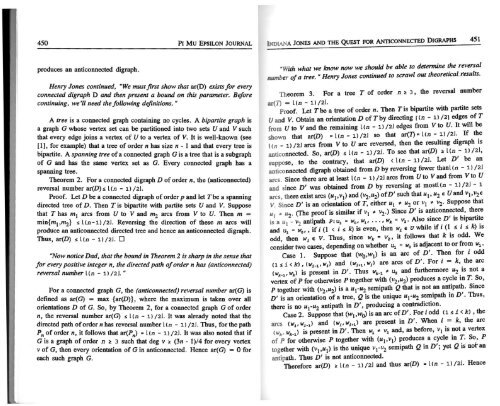Vol. 10 No 6 - Pi Mu Epsilon
Vol. 10 No 6 - Pi Mu Epsilon
Vol. 10 No 6 - Pi Mu Epsilon
- No tags were found...
Create successful ePaper yourself
Turn your PDF publications into a flip-book with our unique Google optimized e-Paper software.
450 PI MU EPSILON JOURNAL<br />
INDIANA JONES AND THE QUEST FOR ANTICONNECTED DIGRAPHS 451<br />
produces an anti connected digraph.<br />
Henry Jones continued, "We must first show that ar(D) exists for every<br />
connected digraph D and then present a bound on this parameter. Before<br />
continuing, we 'II need the following definitions. "<br />
A tree is a connected graph containing no cycles. A bipartite graph is<br />
a graph G whose vertex set can be partitioned into two sets U and V such<br />
that every edge joins a vertex of U to a vertex of V. It is well-known (see<br />
[1], for example) that a tree of order n has size n - 1 and that every tree is<br />
bipartite. A spanning tree of a connected graph G is a tree that is a subgraph<br />
of G and has the same vertex set as G. Every connected graph has a<br />
spanning tree.<br />
Theorem 2. For a connected digraph D of order n, the (anticonnected)<br />
reversal number ar(D) ~ L (n - 1 l /21.<br />
Proof. Let D be a connected digraph of order p and let The a spanning<br />
directed tree of D. Then Tis bipartite with partite sets U and V. Suppose<br />
that T has m 1 arcs from U to V and ~ arcs from V to U. Then m =<br />
min{m 1<br />
,~} ~ L(n-1) /21. Reversing the direction of these m arcs will<br />
produce an anticonnected directed tree and hence an anticonnected digraph.<br />
Thus, ar(D) ~ L (n - 1) /21. 0<br />
"<strong>No</strong>w notice Dad, that the bound in Theorem 2 is sharp in the sense that<br />
for every positive integer n, the directed path of order n has (anticonnected)<br />
reversal number L(n - 1) /2J."<br />
For a connected graph G, the (anticonnected) reversal number ar(G) is<br />
defined as ar(G) = max {ar(D)}, where the maximum is taken over all<br />
orientations D of G. So, by Theorem 2, for a connected graph G of order<br />
n, the reversal number ar(G) ~ L(n - 1) /2J. It was already noted that the<br />
directed path of order n bas reversal number L (n - 1) /21. Thus, for the path<br />
Pn of order n, it follows that ar(Pn) = L(n - 1) /21. It was also noted that if<br />
G is a graph of order n ~ 3 such that deg v ~ (3n - 1)/4 for every vertex<br />
v of G, then every orientation of Gin anticonnected. Hence ar(G) = 0 for<br />
each such graph G.<br />
"With what we know now we should be able to determine the reversal<br />
IUII7Iber of a tree. "Henry Jones continued to scrawl out theoretical. results.<br />
Theorem 3. For a tree T of order n ~ 3 , the reversal number<br />
ar(1) = L(n - 1) /21.<br />
Proof. Let T be a tree of order n. Then T is bipartite with partite sets<br />
U and V. Obtain an orientation D of Thy directing r
















